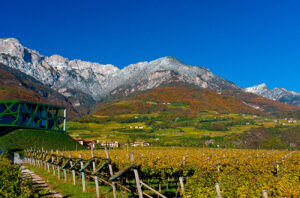[ad_1]  Cantina Tramin vineyards
Cantina Tramin vineyards
Nestled in the dramatic landscapes of northeastern Italy, Trentino-Alto Adige/Südtirol is a region where winemaking is as deeply rooted as the towering Dolomites themselves. This region is known for its pristine mountain air, varied terroirs, a blend of Italian and Germanic influences, and elegance and precision in its wines.
It’s uniquely split into two distinct identities: Trentino, with its Italian heritage and renown for sparkling Trento DOC; and Alto Adige/Südtirol, where Germanic traditions shine through in vibrant whites and expressive reds.
While its reputation has often been linked to fresh, mineral-driven whites and structured reds, the region is stepping into the limelight with a stunning selection of wines that showcase its boundless potential.
Scroll down to discover DWWA 2024 awarded wines
The Decanter World Wine Awards (DWWA) 2024 competition results last year highlighted this region’s consistent excellence, with an impressive Best in Show, six Platinum, 15 Gold and 101 Silver medals in all – a selection of which we show here.
These accolades highlight not only the diversity of varieties thriving in Trentino-Alto Adige/Südtirol, but also the region’s winemaking of finesse and character.
Michael Garner, DWWA Regional Chair for Northern Italy noted: ‘The excellence of the region’s white wines is well established, but the resurgence of its reds should come as no surprise: they dominated production prior to the 1980s.’
At the pinnacle of this excellence in 2024 was Cantina Andrian’s sweet passito Gewürztraminer (see below), awarded Best in Show. A nod to the grape’s origins in Alto Adige, this is a wine of exquisite purity.
Discover more DWWA medal-winning favourites from all over the world at awards.decanter.com
Best in Show
Cantina Andrian, Juvelo Gewürztraminer Passito 2022

Best in Show, 97 points
POA £ Astrum Wine Cellars, Sociovino
We tend to associate Gewürztraminer with Alsace, but its name actually signifies ‘the spicy one from Tramin’. More fruity (fresh peach, nectarine, apricot) than many of its French vendange tardive or sélection de grains nobles peers, this is relatively low in acidity but lusciously rich in sugars – a fruit-tart-in-a-glass, dusted with the finest sugar spice you could imagine. The texture overall is lighter than many sweet Alsace examples, which tend to have richer tannin profiles. It’s the prettiest of dessert wines, and perfect for afternoon tea. Alcohol 11%
Whites
Pinot Bianco
Nals Margreid, Sirmian 2022

Platinum, 97 points
£36.50 NY Wines
Enthralling grapefruit, fresh cut grass and floral aromas abound with a twist of pepper freshness clinging rapturously to the lively acidity. Plump and viscous with a lavish lemony fluidity that trickles towards the end. Superb. Alc 14.5%
Cantina Terlano, Rarity 2011

Gold, 95 points
£225.50 Falcon Vintners, Harrogate Wines, Hedonism, Sociovino
Exuding impeccable maturity and laden with plump nectarine, peach, melon and yellow blossom. Toasty generosity and enlivening mineral undertones. Ample, rich and very long. Alc 14%
Sauvignon Blanc
Kornell, Oberberg 2021

Silver, 94 points
kornell.it
Aromatic nose of cut grass, gooseberry and lychee, followed by a palate of mandarin, grapefruit and mango. Alc 13.5%
Sylvaner
Abbazia di Novacella, Praepositus, Isarco 2022

Gold, 95 points
kloster-neustift.it
Remarkably expressive floral aromas and notes of green tea, grapefruit and pear infuse nicely into the plush texture and stony, mineral acidity. Long and memorable. Alc 14%
White blends
Cantina Terlano, Terlaner Primo Grande Cuvée 2021

Platinum, 97 points
£254 Berry Bros & Rudd, Field & Fawcett, Harrogate Wines, Sociovino
Mango, pineapple and melon, with grassy, floral undertones. Poised and elegant, with impressive mineral structure and citrus acidity. Rich, refreshing and amazingly long. Alc 14%
Kurtatsch, Amos 2022

Gold, 96 points
kellerei-kurtatsch.it
White stone fruit, ripe…
Source : https://www.decanter.com/decanter-world-wine-awards/discovering-trentino-alto-adige-sudtirol-wines-with-elegance-and-diversity-553257/



